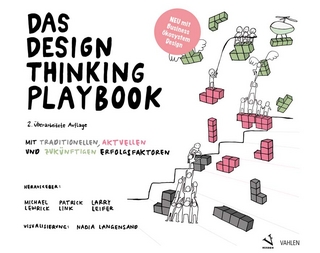
Bayesian Methods for Interaction and Design
Cambridge University Press (Verlag)
978-1-108-79270-7 (ISBN)
Intended for researchers and practitioners in interaction design, this book shows how Bayesian models can be brought to bear on problems of interface design and user modelling. It introduces and motivates Bayesian modelling and illustrates how powerful these ideas can be in thinking about human-computer interaction, especially in representing and manipulating uncertainty. Bayesian methods are increasingly practical as computational tools to implement them become more widely available, and offer a principled foundation to reason about interaction design. The book opens with a self-contained tutorial on Bayesian concepts and their practical implementation, tailored for the background and needs of interaction designers. The contributed chapters cover the use of Bayesian probabilistic modelling in a diverse set of applications, including improving pointing-based interfaces; efficient text entry using modern language models; advanced interface design using cutting-edge techniques in Bayesian optimisation; and Bayesian approaches to modelling the cognitive processes of users.
John H. Williamson is Senior Lecturer in Computing Science at the University of Glasgow. He holds B.Sc. and Ph.D. degrees from the University of Glasgow. His Ph.D. thesis was on continuous models of interactive systems with uncertainty. He is an expert in modelling and machine learning for continuous-control interfaces, multimodal feedback and uncertainty in interactive systems. His work is widely recognised, with several awards at the ACM SIGCHI conference. He is among the leaders of the Computational Interaction movement, and founded the international Summer School on Computational Interaction. Antti Oulasvirta is Professor of Electrical Engineering and leads the User Interfaces research group at Aalto University and the Interactive AI research program at the Finnish Center for AI. He was previously Senior Researcher at the Max Planck Institute for Informatics. His work has been awarded the Best Paper Award and Best Paper Honorable Mention at CHI 13 times. He has given keynotes at NordiCHI'14, CoDIT'14, EICS'16, IHCI'17, ICWE'19 and Chinese CHI '19. He is a member of the European Laboratory for Learning and Intelligent Systems and of the Finnish Academy of Science and Letters. Per Ola Kristensson is Professor of Interactive Systems Engineering in the Department of Engineering at the University of Cambridge and a Fellow of Trinity College, Cambridge. In 2007 he co-founded ShapeWriter to commercialise gesture keyboard technology based on his Ph.D. thesis. ShapeWriter won a Google Android ADC50 developer award and was selected as the 8th best iPhone application by Time in 2008. Kristensson has been named an Innovator Under 35 by MIT Technology Review and awarded the ACM UIST Lasting Impact Award, the Royal Society of Edinburgh Early Career Prize, and the Sir Thomas Makdougall Brisbane Medal. He is an Associate Editor of ACM TOCHI and ACM TIIS. Nikola Banovic is Assistant Professor of Electrical Engineering and Computer Science at the University of Michigan–Ann Arbor. He received his Ph.D. from the Human-Computer Interaction Institute (HCII) at Carnegie Mellon University, and his B.Sc. and M.Sc. degrees from the University of Toronto. His research interests include computational approaches to studying human-computer interaction, with a focus on explainability and interpretability of complex computational systems, and ethical and equitable computing technologies. His publications include award-winning research on methods to study and model human behaviour in premier HCI conferences.
Preface Nikola Banovic, Per Ola Kristensson, Antti Oulasvirta and John H. Williamson; Part I. Introduction to Bayesian Methods: 1. An introduction to Bayesian methods for interaction design John H. Williamson; 2. Bayesian statistics Alan Dix; Part II. Probabilistic Interfaces and Inference of Intent: 3. Bayesian information gain to design interaction Wanyu Liu, Olivier Rioul and Michel Beaudouin-Lafon; 4. Bayesian command selection Suwen Zhu, Xiangmin Fan, Feng Tian and Xiaojun Bi; 5. Probabilistic UI representation and reasoning in touch interfaces Daniel Buschek; 6. Statistical keyboard decoding Dylan Gaines, John Dudley, Per Ola Kristensson and Keith Vertanen; 7. Human–Computer interaction design and inverse problems Roderick Murray-Smith, John H. Williamson and Francesco Tonolini; Part III. Bayesian Optimisation in Interaction Design: 8. Preferential Bayesian optimisation for visual design Yuki Koyama, Toby Chong and Takeo Igarashi; 9. Bayesian optimisation of interface features John Dudley and Per Ola Kristensson; Part IV. Bayesian Cognitive Modelling: 10. Cue integration in input performance Byungjoo Lee; 11. Bayesian parameter inference for cognitive simulators Jussi P.P. Jokinen, Ulpu Remes, Tuomo Kujala and Jukka Corander; Part V. Appendix. Mathematical background and notation John H. Williamson.
| Erscheinungsdatum | 17.08.2022 |
|---|---|
| Zusatzinfo | Worked examples or Exercises |
| Verlagsort | Cambridge |
| Sprache | englisch |
| Maße | 151 x 228 mm |
| Gewicht | 550 g |
| Themenwelt | Geisteswissenschaften ► Psychologie ► Allgemeine Psychologie |
| Geisteswissenschaften ► Psychologie ► Verhaltenstherapie | |
| Informatik ► Software Entwicklung ► User Interfaces (HCI) | |
| Informatik ► Theorie / Studium ► Künstliche Intelligenz / Robotik | |
| ISBN-10 | 1-108-79270-7 / 1108792707 |
| ISBN-13 | 978-1-108-79270-7 / 9781108792707 |
| Zustand | Neuware |
| Informationen gemäß Produktsicherheitsverordnung (GPSR) | |
| Haben Sie eine Frage zum Produkt? |
aus dem Bereich


